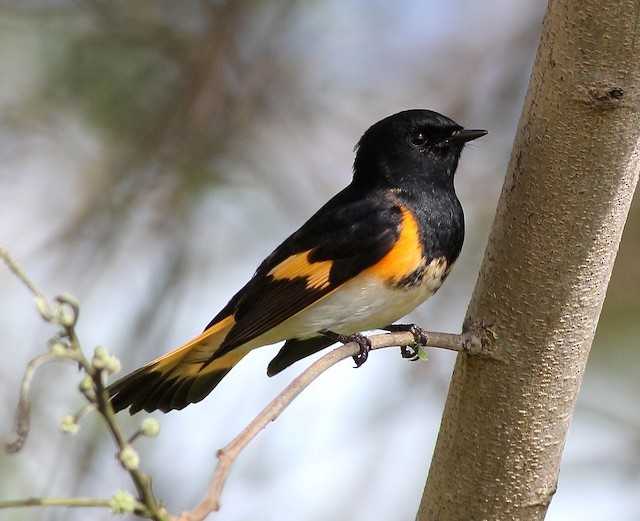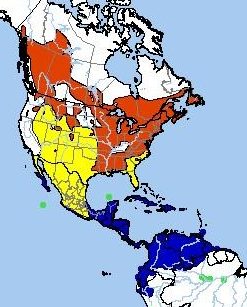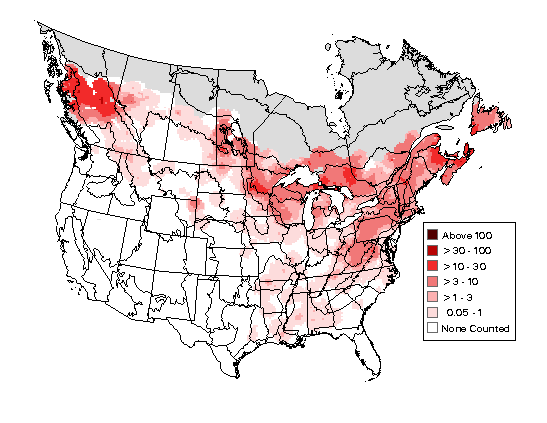Birdfinding.info ⇒ Widespread and common across most of its range. Among the most familiar migrant warblers in the eastern U.S., where it is continuously present from April into October. Breeds abundantly in suitable habitat over large portions of Canada and the northeastern U.S. (see Breeding Bird Survey Abundance Map in Notes, below). In winter, especially common in West Indian mangroves.
American Redstart
Setophaga ruticilla
Breeds in North America. Winters in Middle America, the West Indies, and northern South America.
Breeding. Deciduous and mixed woodlands from the southeastern Alaska to Newfoundland, south to Oregon, eastern Texas, and the Florida Panhandle. A localized and sporadic breeder across most of the western U.S. south to Arizona, mainly in riparian corridors.
Small numbers remain in Cuba during the summer and have been found breeding there on multiple occasions.
Nonbreeding. Winters in all types of woodlands, scrub, gardens, and edge habitats from southern California and the U.S. Gulf Coast south to northwestern Peru, northernmost Brazil, and the Guianas. Especially numerous in Caribbean mangroves.
Movements. Migrates nearly throughout North America, but far more numerous east of the Great Plains. Has occurred as vagrant several times in western Europe and Macaronesia.
Identification
Adult male is distinctive: black above, with broad orange patches on its wings, tail, and sides.
Habitually fans its wings and tail as it forages. Pursues insects in acrobatic, fluttering sallies.

American Redstart, male. (Dolores, Petén, Guatemala; April 12, 2018.) © Juan Miguel Artigas Azas
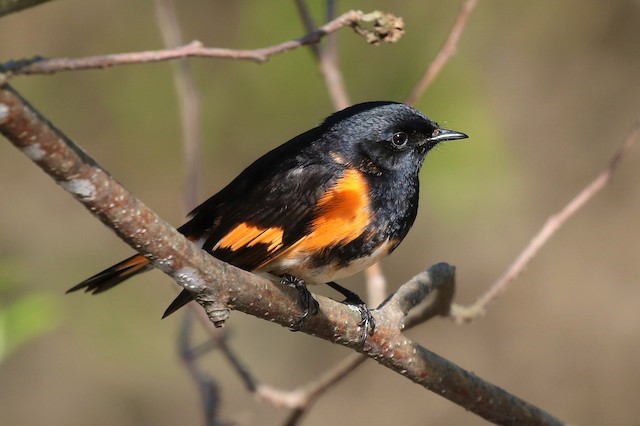
American Redstart, male. (Pine Creek Park, Beechwood, Michigan; May 10, 2018.) © Eric Gustafson
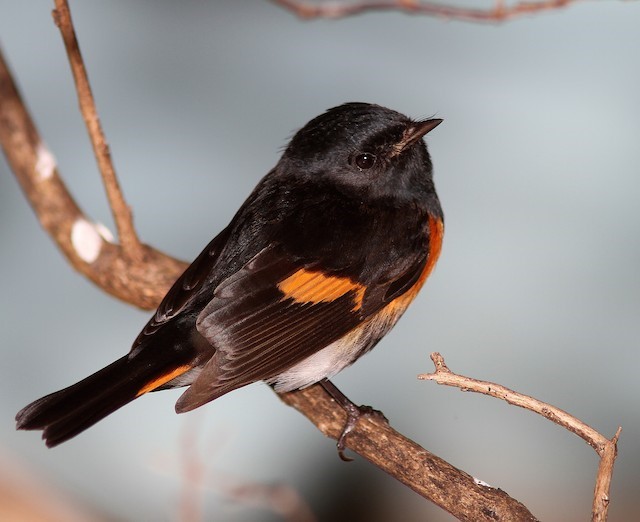
American Redstart, male. (El Cubano National Park, Cuba; January 2, 2014.) © Guy Poisson
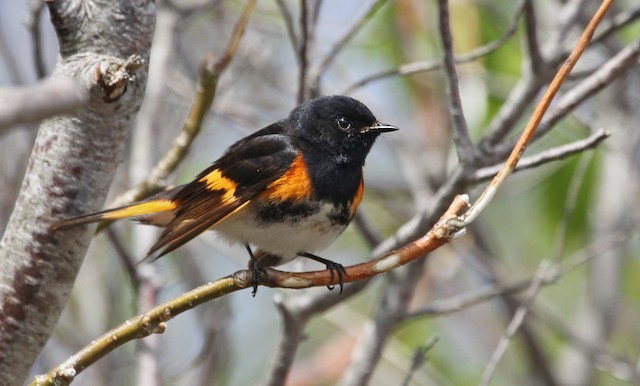
American Redstart, male. (Plum Island, Massachusetts; May 13, 2011.) © Ryan Schain
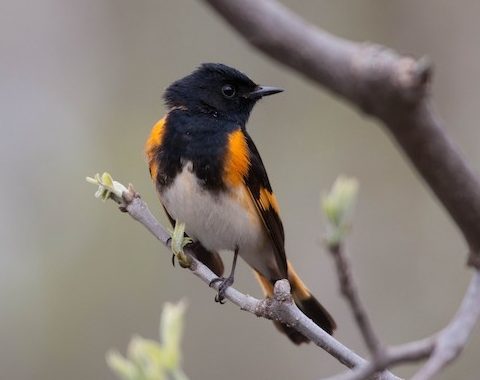
American Redstart, male. (Magee Marsh, Ohio; May 7, 2016.) © Tanner Martin
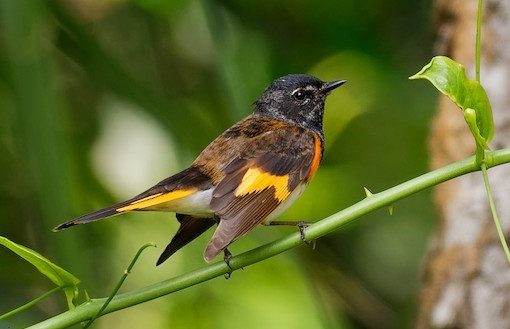
American Redstart, male with largely brown back—an occasional variant plumage. (Fort Caroline National Memorial, Jacksonville, Florida; April 26, 2018.) © Don Danko
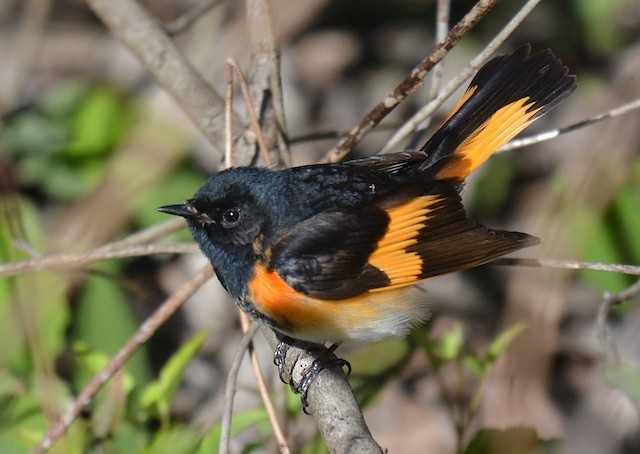
American Redstart, male with wings and tail partly spread. (Beaver Lake Bird Sanctuary, Asheville, North Carolina; April 20, 2018.) © Jay Wherley
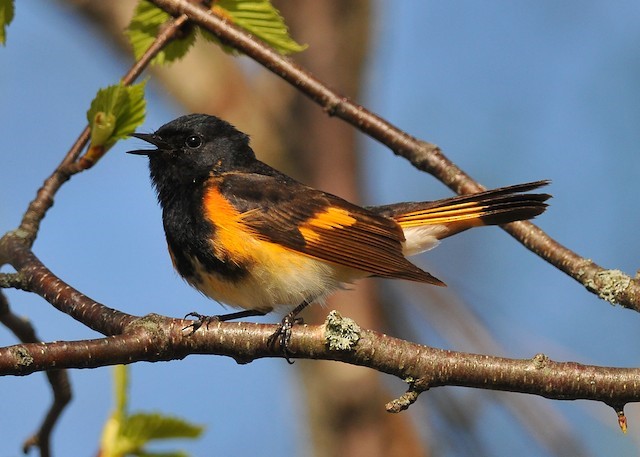
American Redstart, male. (Sainte-Marie-de-Kent, New Brunswick; May 22, 2011.) © Denis Doucet

American Redstart, male. (Reef Golf Course, Freeport, Grand Bahama; March 5, 2018.) © Christopher Johnson

American Redstart, male. (Little Beach, New Brunswick; July 1, 2018.) © Jim Carroll
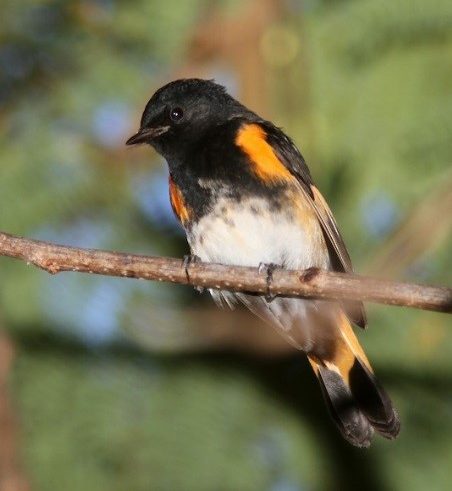
American Redstart, male. (El Cubano National Park, Cuba; January 2, 2014.) © Guy Poisson
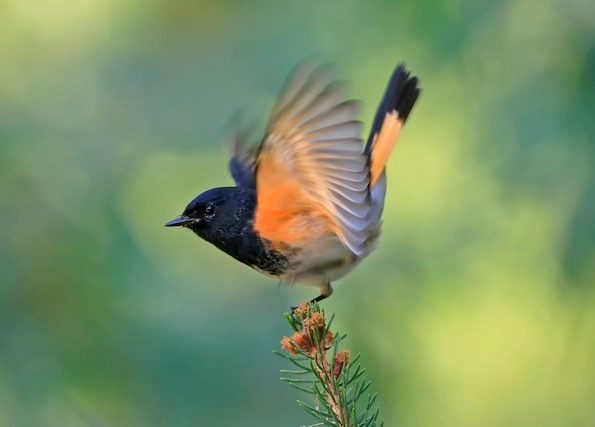
American Redstart, male showing extensively orange underwings. (Morris, Illinois; September 10, 2017.) © Don Blecha
Female has a grayish head and otherwise olive upperparts, with broad yellow patches on its tail, narrow yellow patches on its wings, and a variable yellow wash on the sides—similar to the male’s pattern, but with different colors.

American Redstart, female. (Hudson Mills Metropark, Washtenaw County, Michigan; May 21, 2017.) © Brendan Klick

American Redstart, female or immature male. (Saskatoon, Saskatchewan; August 16, 2017.) © Nick Saunders
Immature males are very similar to females, and remain so until their second fall. They differ in usually having more extensive yellow patches on the wings and sides.
The shades of yellow on young males—especially on the sides—tend to be more orange than on females. They often have a few black feathers—especially on the face and rump—long before molting into adult plumage.
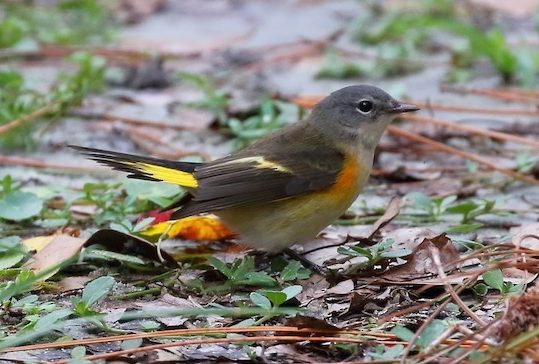
American Redstart, immature male—note blackish feathers on face and orange on the side of the chest. (Jacksonville, Florida; October 3, 2017.) © Newton Wallen
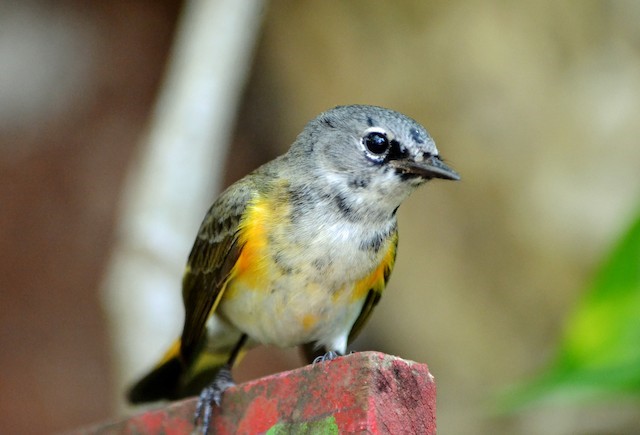
American Redstart, immature male. (Finca Festa Campesina, Matanzas, Cuba; April 8, 2016.) © Michael J. Good

American Redstart, immature male. (Bubali Bird Sanctuary, Aruba; September 24, 2018.) © Michiel Oversteegen
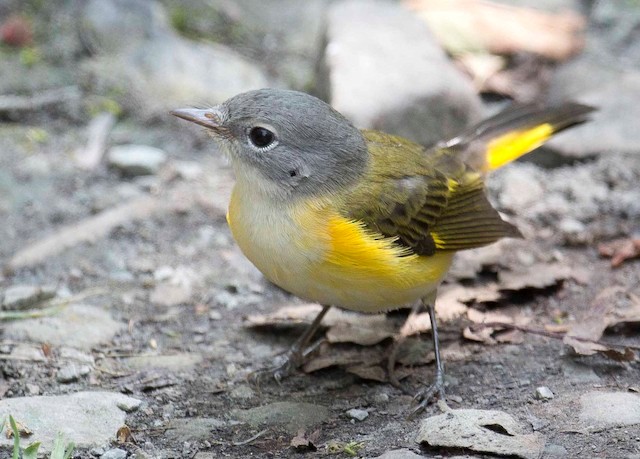
American Redstart, female. (Bittania Conservation Area, Ottawa, Ontario; August 25, 2017.) © Tom Devesceri

American Redstart, female. (Rainbow Beach Park, South Chicago, Illinois; September 17, 2016.) © Carl Giometti
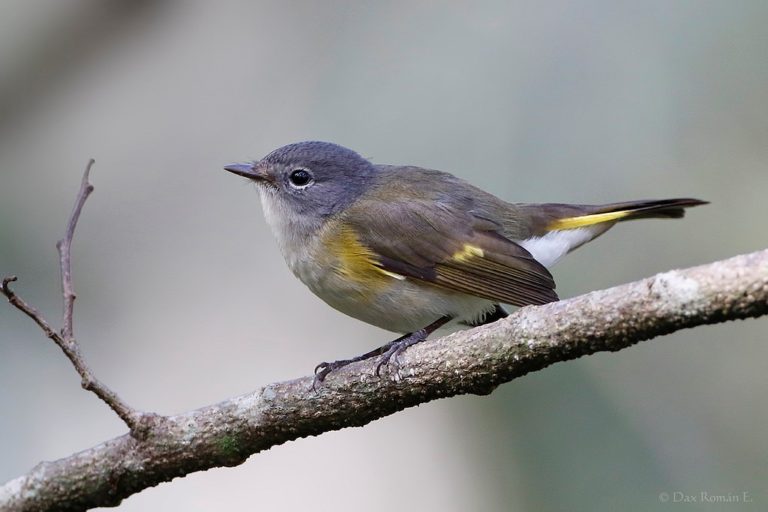
American Redstart, female. (Santo Domingo, Dominican Republic; March 5, 2016.) © Dax M. Román E.
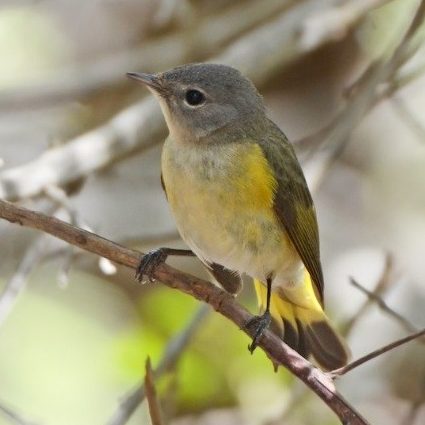
American Redstart, female. (Spaans Lagoon, Aruba; April 12, 2013.) © Steven Mlodinow

American Redstart, immature male. (Dominican Republic; December 8, 2013.) © Dax M. Román E.

American Redstart, immature female—note that the wing patch is small enough to be concealed when the wing is folded. (Big Water Farm, Queen Anne’s County, Maryland; September 19, 2018.) © Daniel Irons
Voice. Song is highly variable, most often a short, rapid series of similar high-pitched notes that ends with a lower note: Sometimes ends with a 2- or 3-note phrase:
Notes
Monotypic species.
References
Alderfer, J., and J.L. Dunn. 2014. National Geographic Complete Birds of North America (Second Edition). National Geographic Society, Washington, D.C.
Dunn, J.L., and K.L. Garrett. 1997. A Field Guide to Warblers of North America. Houghton Mifflin, Boston.
eBird. 2019. eBird: An online database of bird distribution and abundance. Cornell Lab of Ornithology, Ithaca, N.Y. http://www.ebird.org. (Accessed March 30, 2019.)
ffrench, R. 2012. A Guide to the Birds of Trinidad & Tobago (Third Edition). Cornell University Press, Ithaca, N.Y.
Garcia-del-Rey, E. 2011. Field Guide to the Birds of Macaronesia: Azores, Madeira, Canary Islands, Cape Verde. Lynx Editions, Barcelona.
Garrido, O.H, and A. Kirkconnell. 2000. Field Guide to the Birds of Cuba. Cornell University Press, Ithaca, N.Y.
Haynes-Sutton, A., A. Downer, R. Sutton, and Y.-J. Rey-Millet. 2009. A Photographic Guide to the Birds of Jamaica. Princeton University Press, Princeton, N.J.
Howell, S.N.G., and S. Webb. 1995. A Guide to the Birds of Mexico and Northern Central America. Oxford University Press, Oxford.
Latta, S., C. Rimmer, A. Keith, J. Wiley, H. Raffaele, K. McFarland, and E. Fernandez. 2006. Birds of the Dominican Republic and Haiti. Princeton University Press, Princeton, N.J.
Raffaele, H. 1989. A Guide to the Birds of Puerto Rico and the Virgin Islands. Princeton University Press, Princeton, N.J.
Raffaele, H., J. Wiley, O. Garrido, A. Keith, and J. Raffaele. 1998. A Guide to the Birds of the West Indies. Princeton University Press, Princeton, N.J.
Ridgely, R.S., and G. Tudor. 2009. Field Guide to the Songbirds of South America: The Passerines. University of Texas Press, Austin.
Salt, W.R., and J.R. Salt. 1976. The Birds of Alberta. Hurtig Publishers, Edmonton, Alberta.
Wells, J.V., and A.C. Wells. 2017. Birds of Aruba, Bonaire, and Curaçao. Cornell University Press, Ithaca, N.Y.
